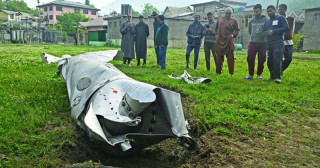Cyclops
Minister (2k+ posts)
Cairo, Egypt -The hazy desert that extends from the outskirts of Cairo has become the unlikely scene of another revolution that has the potential to transform Egypt - and it is green.
Inhospitable, yellowed wasteland is now yielding up ripe red tomatoes, fresh kale and schools of fish in a bold experiment fuelled by the country's most precious resource: water.
This surprising harvest illustrates how Egypt is witnessing a slow transformation in attitudes towards the environment driven by groups such as Greenpeace and Nawaya alongside an innovative young sustainability movement.
In the vanguard of this movement is Faris Farrag, an Egyptian banker inspired by a love of growing plants and fishing, who has embraced the revolutionary technique of aquaponics at his unassuming farm outside Cairo called "Bustan" (Arabic for orchard).
"As the price of water soars, as the price of petrol soars, and when the subsidies on farming disappear, this model makes sense," says Farrag.
Reviving ancient techniques
Aquaponics, an ancient form of cultivation that originated with the Aztecs, enables farmers to increase yields by growing plants and farming fish in the same closed freshwater system.
Farrag studied the technique under Dr James Rakocy at the University of the Virgin Islands, whose sustainable farming method grew in popularity in the 1980s and is now gaining mainstream acceptance in developing nations.
Enterprising farmers have implemented the system in countries as diverse as Bangladesh, the United Arab Emirates and Yemen to save water and increase output.
At Bustan, the first commercial aquaponics farm in Egypt, olive trees flank the growing areas sprouting from what seems to be sandy ground, and dusty mesh screens are the only barriers protecting delicate young plants from the expansive tracts of sand.
Water circulates from tanks hosting schools of fleshy Nile tilapia through hydroponic trays which grow vegetables including cucumber, basil, lettuce, kale, peppers and tomatoes on floating foam beds with run-off flushed out to irrigate the trees.
It is an ingenious solution to an old problem in a country dominated by unforgiving deserts where access to fresh water is a luxury in many areas.
The Nile supplies Egypt with almost all its water, 85 percent of which goes to agriculture - but the country has long outgrown agreements with neighbours on its share of this resource as its population has soared to 85 million, and is pressing to renegotiate terms.
Earlier this year the most populous Arab nation made global headlines in an angry disagreement over plans to dam the Blue Nile, denouncing Ethiopia's attempts to reroute the river.
- See more at: http://gardenreboot.blogspot.com/2013/10/egypt-aims-for-revolution-in-desert.html
Inhospitable, yellowed wasteland is now yielding up ripe red tomatoes, fresh kale and schools of fish in a bold experiment fuelled by the country's most precious resource: water.
This surprising harvest illustrates how Egypt is witnessing a slow transformation in attitudes towards the environment driven by groups such as Greenpeace and Nawaya alongside an innovative young sustainability movement.
In the vanguard of this movement is Faris Farrag, an Egyptian banker inspired by a love of growing plants and fishing, who has embraced the revolutionary technique of aquaponics at his unassuming farm outside Cairo called "Bustan" (Arabic for orchard).
"As the price of water soars, as the price of petrol soars, and when the subsidies on farming disappear, this model makes sense," says Farrag.
Reviving ancient techniques
Aquaponics, an ancient form of cultivation that originated with the Aztecs, enables farmers to increase yields by growing plants and farming fish in the same closed freshwater system.
Farrag studied the technique under Dr James Rakocy at the University of the Virgin Islands, whose sustainable farming method grew in popularity in the 1980s and is now gaining mainstream acceptance in developing nations.
Enterprising farmers have implemented the system in countries as diverse as Bangladesh, the United Arab Emirates and Yemen to save water and increase output.
At Bustan, the first commercial aquaponics farm in Egypt, olive trees flank the growing areas sprouting from what seems to be sandy ground, and dusty mesh screens are the only barriers protecting delicate young plants from the expansive tracts of sand.
Water circulates from tanks hosting schools of fleshy Nile tilapia through hydroponic trays which grow vegetables including cucumber, basil, lettuce, kale, peppers and tomatoes on floating foam beds with run-off flushed out to irrigate the trees.
It is an ingenious solution to an old problem in a country dominated by unforgiving deserts where access to fresh water is a luxury in many areas.
The Nile supplies Egypt with almost all its water, 85 percent of which goes to agriculture - but the country has long outgrown agreements with neighbours on its share of this resource as its population has soared to 85 million, and is pressing to renegotiate terms.
Earlier this year the most populous Arab nation made global headlines in an angry disagreement over plans to dam the Blue Nile, denouncing Ethiopia's attempts to reroute the river.
- See more at: http://gardenreboot.blogspot.com/2013/10/egypt-aims-for-revolution-in-desert.html
Last edited by a moderator:




































